Dylan Cease gathered some media attention this spring when he recited a poem he wrote about his slider. Cease has all the reason to be infatuated with his slider, it propelled him to a Cy Young runner-up campaign in 2022, with a league-leading run value of 36. Even in his comparatively poor 2023 season, Cease’s slider generated a run value of +10, among the very best breaking balls in the league.
But it’s not his slider that this article is about, nor is it about his knuckle curve (which, true story, in 2021 made me once stop eating my deep dish pizza on a trip to Chicago to talk about its ridiculous movement). No, instead this is about the pitch Dylan Cease threw just 99 times last year—his changeup—which is absolutely bonkers. Unlike many ridiculous pitches, however, it’s not bonkers because of its movement, whiff rates, spin rates, or anything like that.
It may be a bold claim to say that Cease’s change is the “most ridiculous pitch in baseball” given how many bona-fide absurd pitches there are in today’s game. Pitches like Devin Williams‘ Airbender changeup, Jhoan Duran’s 99 mph+ Splinker, Tyler Rogers‘ rising slider, and Jacob deGrom’s everything probably all could qualify for that title, but stay patient! I will reveal why it’s in fact Dylan Cease’s seldom-thrown change that is most deserving of the “Most Ridiculous Pitch in Baseball” title. But first, let’s just talk changeups.
Changing Tides
Throughout most of baseball history, a changeup was a pitch thrown to look like a fastball out of the hand, but come up slow, causing the batter to catch nothing but air. A changeup traditionally sat around 10-15 mph behind the 4-seam, but modern pitchers tend to throw a sort of power change. Take Logan Webb for instance:
Webb’s changeup velocity has crept up over the years to sit in the high 80s, occasionally breaking 90 mph, sitting less than 5 ticks below his sinker velocity. These changeups—brought on by pitchers like Félix Hernández—are effective because they can work independently of the fastball, and are especially powerful against opposite-handed hitters. Take a look at the velo ranges of Webb’s three-pitch mix:
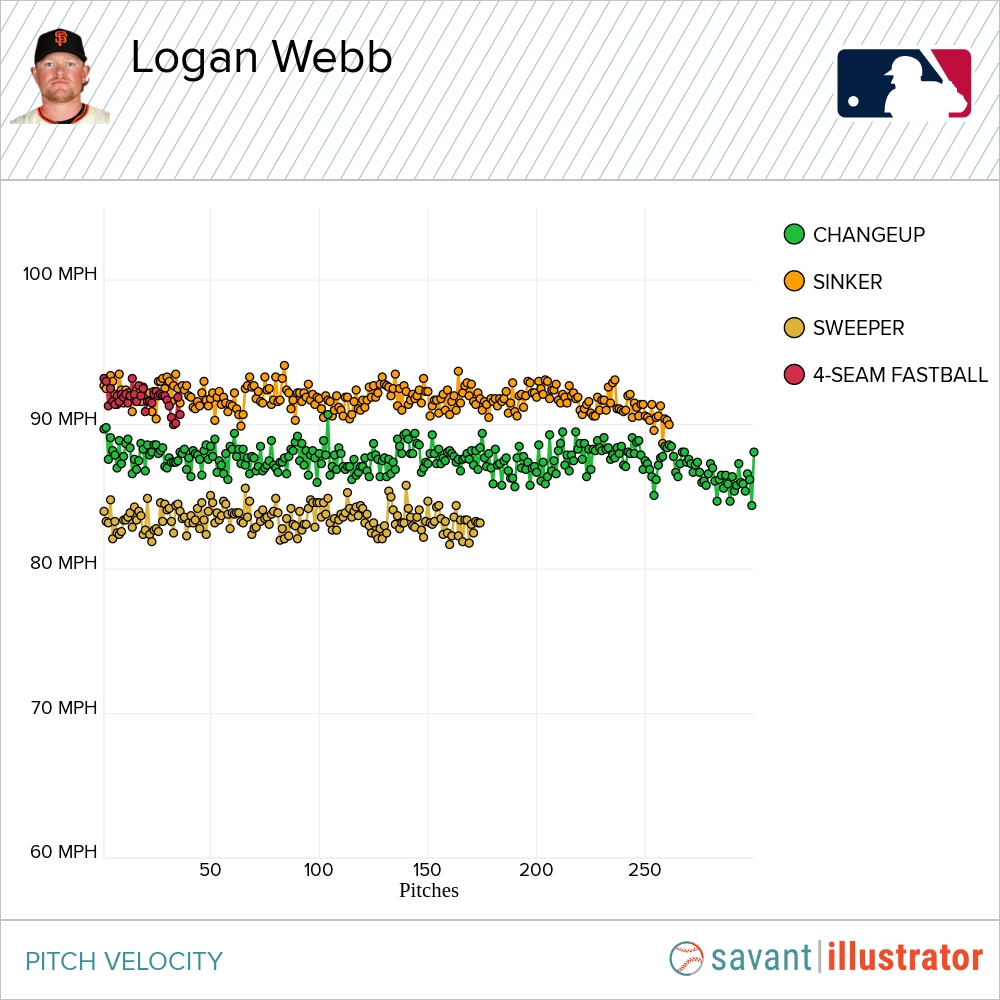
Source: Baseball Savant
Webb is far from the only pitcher to throw a power change. Sandy Alcantara employs a changeup that’s thrown as hard as many pitchers’ fastballs. Alcantara’s change proved to be extremely effective at dealing with LHH, throwing it 37% of the time to lefties en route to his 2022 Cy Young, compared to just 15% usage against righties. Alcantara’s 92 mph changeup is, in many ways, the apotheosis of the power change, combining movement and deception with raw velo to dismantle batters. Take a look at his 2022 PLV charts, which show just how effective his changeup was:
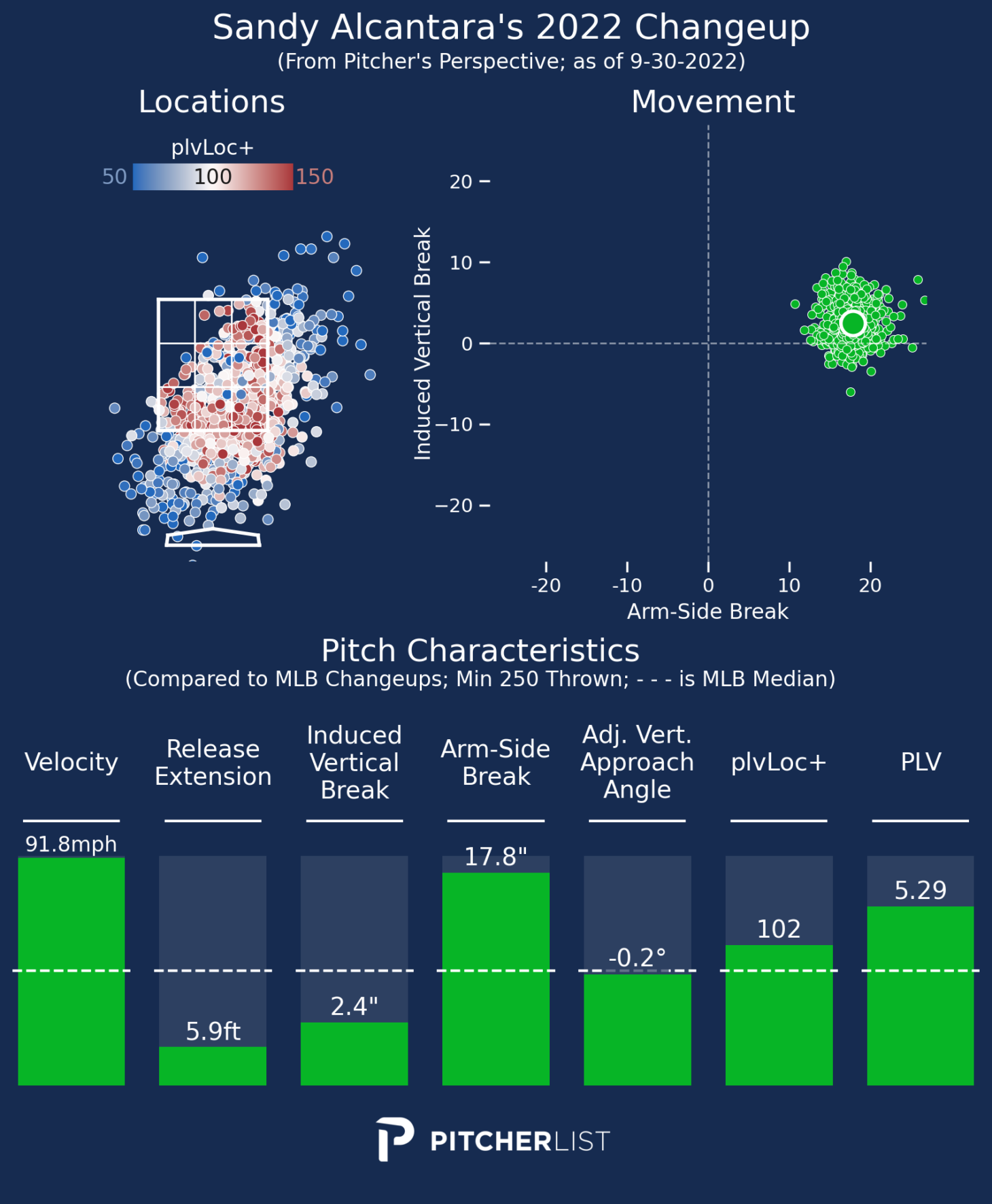
An exemplary power change if there ever was one. Alcantara’s change might be the very best power change in baseball and represents the significant shift in making changeups much more dynamic pitches.
Dylan Cease does not employ a power changeup. Instead, he employs a pitch that, for all intents and purposes, nearly defies all categorization whatsoever. I mean, just look at this:
This particular pitch to Shohei clocked in at 73.2 mph, a full 22 mph behind his 4-seamer. That 4-seamer is absolutely what Ohtani was looking for here, and Cease dropped in a pitch at a velocity many major leaguers haven’t seen since high school. This pitch is bonkers. It’s ludicrous. It’s absurd. It’s checks thesaurus farcical. It is an absolutely ridiculous pitch. Let’s talk about why.
Ridiculous
A 22 mph difference between a changeup and a 4-seam is nearly unheard of, and when compared to other changeups thrown around MLB, its uniqueness really stands out. Here are the 5 largest differences between changeup and 4-seam velo across MLB in 2023:
Credit to Julian Merryweather, who is the only other pitcher really in Cease’s ZIP code, but Cease’s 21 mph difference still sits far ahead of any other pitchers. Here’s what that looks like in graph form:
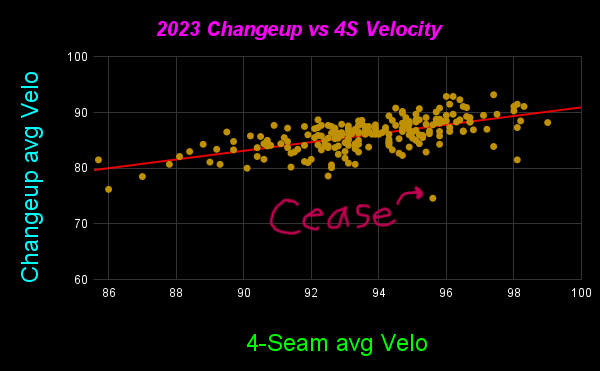
Pretty outrageous. As you might expect, pitch modeling reacts strangely to this unicorn pitch. When taking into account its bizarre characteristics, PLV grades it pretty favorably, albeit with wild ratings:
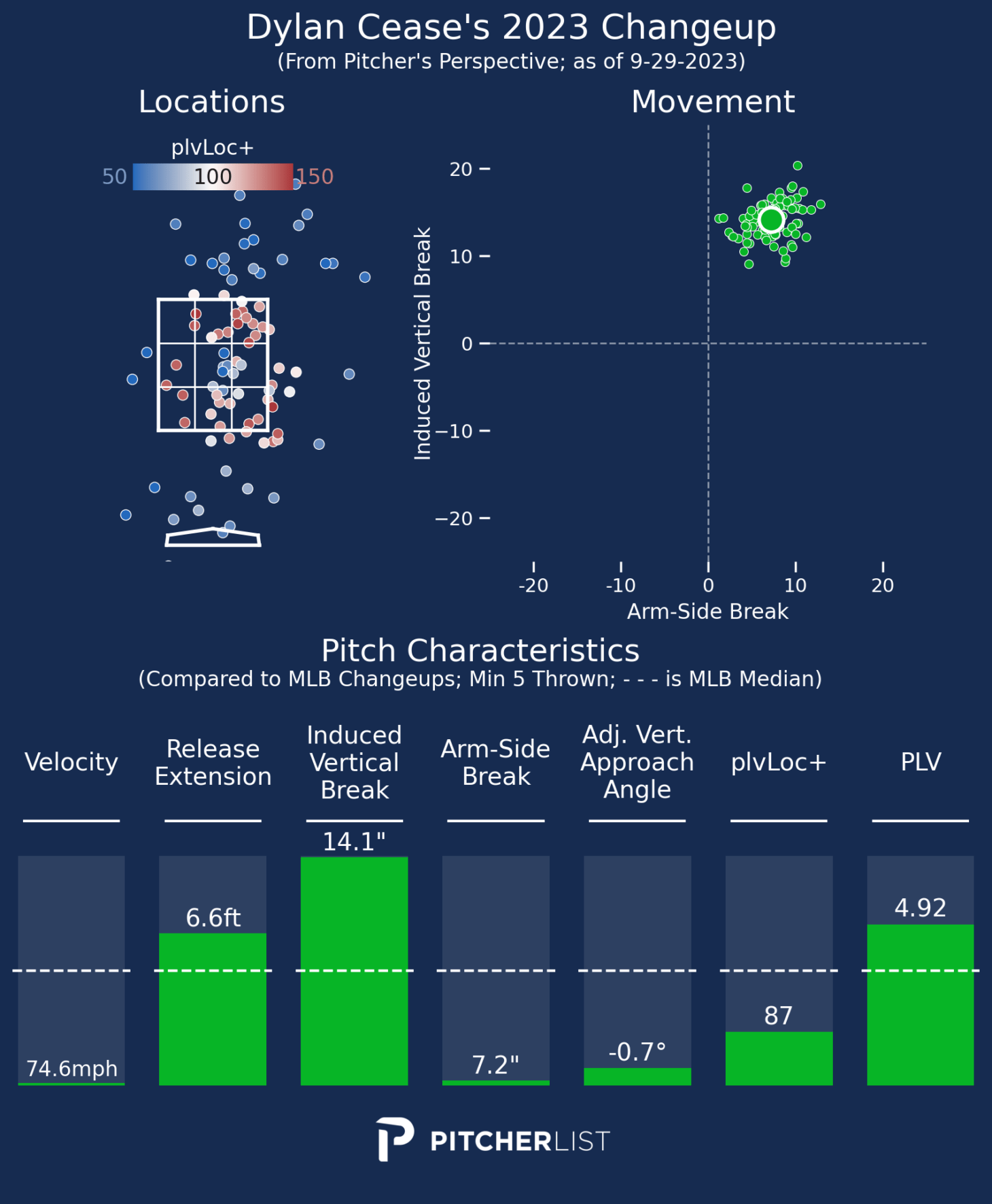
Absolutely ridiculous. Rarely is there a pitch that generates such bipolar results.
Oddly enough, this changeup evolved over the course of the season. Cease started his 2023 throwing a relatively normal changeup – still slow – but in April it was clocking in at 78 mph. Then Cease presumably got an idea. A bizarre idea. An idea that would mess with both pitch modeling and opposing hitters alike: “What if I just threw my changeup even slower?”
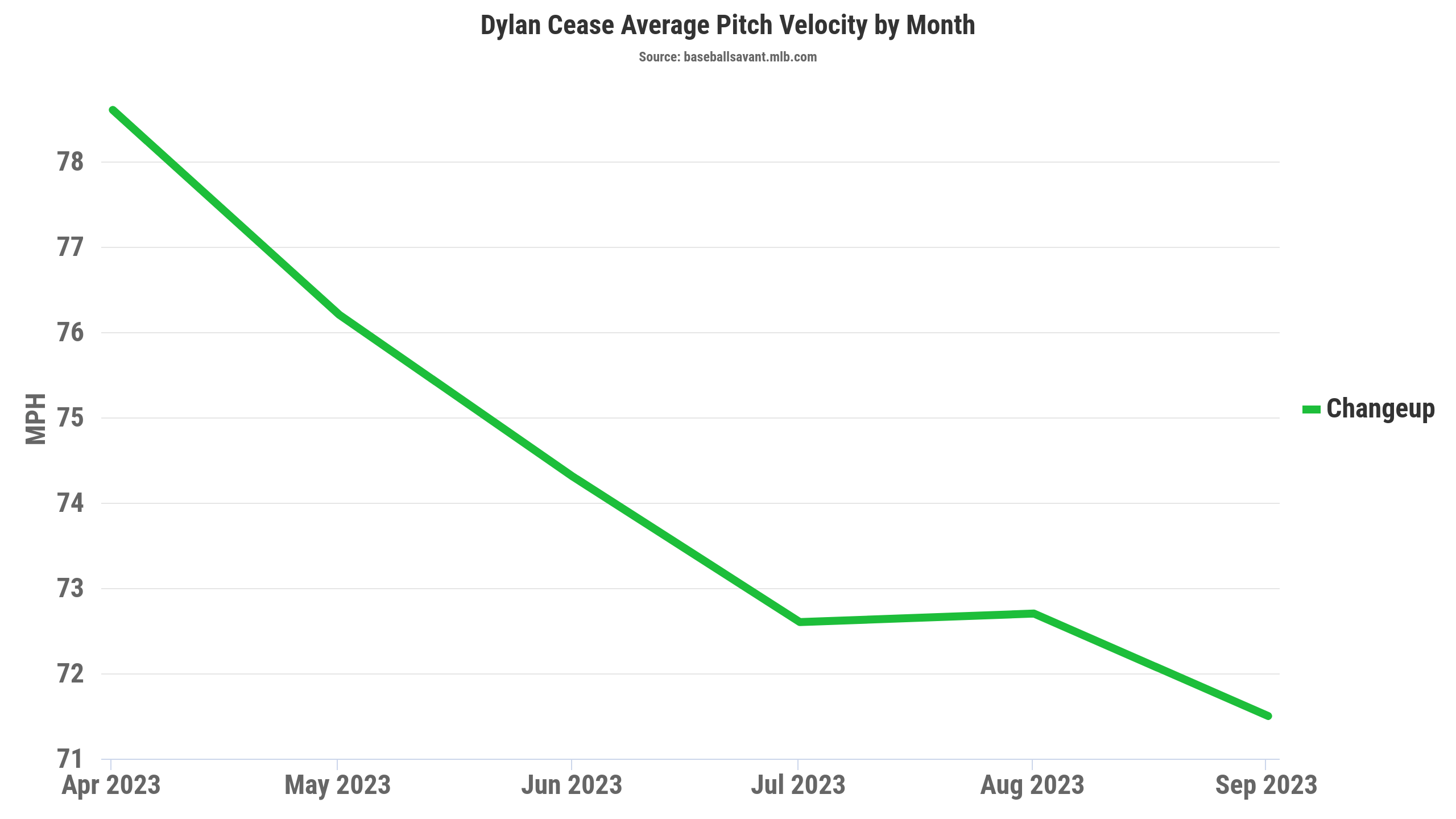
Source: Baseball Savant
By the all-star break, Cease’s change was coming in below interstate speeds. Equally interesting was that this pitch seemed to be working, as after April no hits were recorded against his change. Much of that is due to its erratic location, only finding the zone 35% of the time, but its xwOBA against despite that was still .160.
Cease’s changeup is not a pitch that is thrown very often. He only threw it 99 times all of last season, and almost exclusively to LHH. Yet, while this pitch is seldom used, it differs from, say, a Zack Greinke slow curve because it is very much a real part of Cease’s arsenal. Greinke’s iconic eephuses were only thrown once in a blue moon, but Cease threw his changeup 6% of the time to lefties last year, more than enough to make it a legitimate pitch. This isn’t just some strange oddity like George Kirby throwing a knuckleball, this is a real pitch – and an exceptionally goofy one.
Padre Pandemonium
Since being traded to the Padres, Dylan Cease has seemingly regained the form he exhibited when he posted a 2.20 ERA in 2022 with the White Sox. His fastball velocity is back up to sitting 96-97, and his slider has once again proven extremely effective. PLV reaffirms this, as his grades so far from 2024 are up across the board:
Cease has also added both a Sweeper and Cutter – albeit with mixed success – in order to be more effective against platoon splits. He’s been strong so far, with a 3.05 ERA and peripheral metrics that (mostly) back up his performance.
Ah, but his changeup. The black sheep of his pitch arsenal. What has Cease done to the pitch that I have now written a thousand words about?
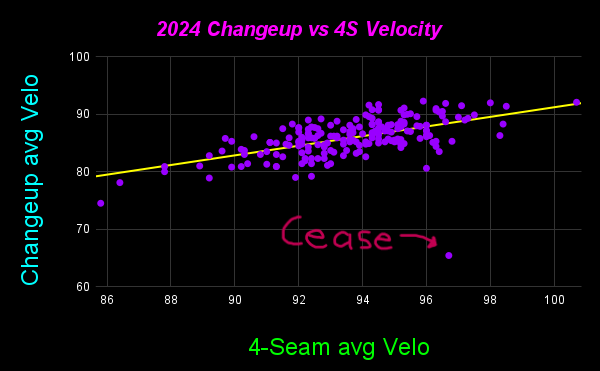
HAHAHAHAHAHAHAHAHAHAHAHAHAHAHAHAHAHAHAHAHAHAHAHAHAHAHAHAHAHAHAHAHAHAHAHAHAHAHAHAHAHAHAHAHAHAHAHAHAHAHAHAHAHAHA
Man, what in the world.
Cease now throws his unicorn changeup at 66 mph, NINE TICKS off his velo in 2023, which has made the already absurd difference between his changeup and four-seam absolutely staggering. Hopefully, by now you’ve figured out I love charts and tables, so here’s another one:
He’s lapped them! A THIRTY-ONE mph difference. That is the most ridiculous pitch in baseball. With all due respect to Jhoan Duran, Devin Williams, and Tyler Rogers, there isn’t a single pitch in baseball with such ludicrous characteristics as this changeup. Just look at PLV try to reconcile with this monstrosity/work of art:
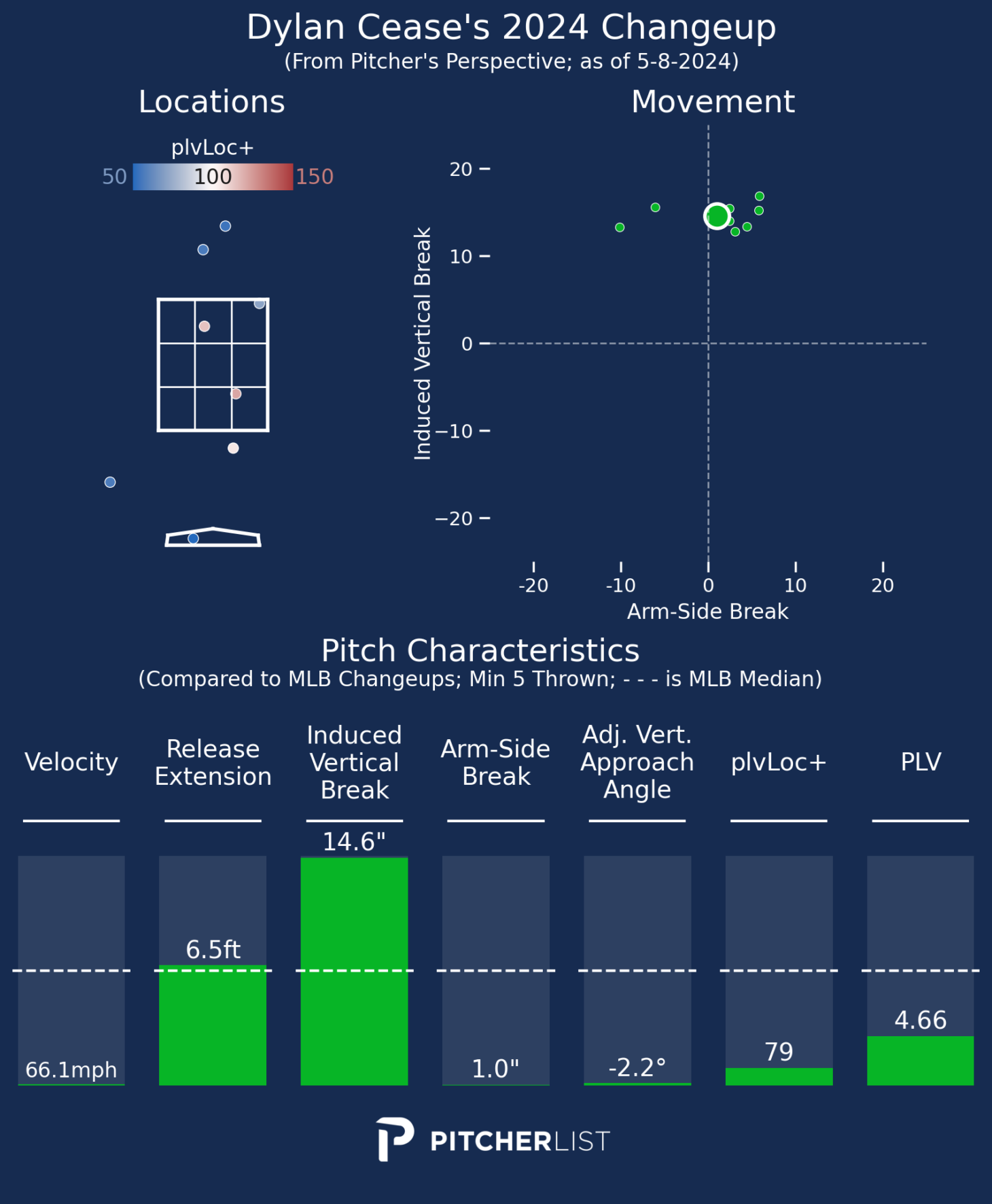
A special shoutout is needed here to our own Kyle Bland, who altered his models specifically so I can make graphs about Cease’s changeup. That’s the perks of having smart friends folks, you can ask them to help with your wacky shenanigans.
Kyle’s model tries its best, but maybe this pitch is beyond proper analysis. If you thought the changeup to Shohei earlier was nuts, just look at this:
Cease. What in the WORLD.
You might think that a pitch that’s this much of an outlier is thrown in an especially different way, but out of the hand, it appears relatively normal. A proper changeup relies primarily on utilizing deception against a fastball, so here’s Cease’s fastball and changeup release points:

Yep. That’s a changeup alright.
Hopefully, you get the idea. Dylan Cease throws a changeup that goes 66 mph, and there’s nothing even remotely like it.
The Albatross
We’ve established this pitch’s absurdity, but one thing it lacks, however, is a cool nickname. The aforementioned pitches from Duran, Williams, and Rogers all have names like “Airbender” and “UFO Slider.” If a pitch is truly to be called the most ridiculous in baseball, it needs a fitting name.
So I propose that Dylan Cease’s change is henceforth known as the Albatross changeup. This is for two reasons: First, in reference to the seabird, which – like Cease’s change – majestically glides at 67 miles per hour. Its ability to endlessly soar has baffled ornithologists for decades, and in a similar sense, Cease’s changeup’s ability to defy traditional pitch categorization has baffled baseball writers.
This brings me to the second reason, which is that an “albatross” refers to something that greatly hinders the ability to achieve something. As baseball statisticians try to make models to quantify the effectiveness of pitches, a looping 66 mph changeup breaks these models—just look at Thomas Nestico (@TJStats) grumble about Cease’s change:
Dylan Cease's new changeup may have me retraining my tjStuff+ model because it graded out catastrophically terrible
Its movement and velocity are truly unique, as it has a movement profile similar to a 4-Seam but thrown at the speed of an eephus. The model hates it. pic.twitter.com/jLt9tPDaD9
— Thomas Nestico (@TJStats) March 31, 2024
Pitch modeling has gone a long way, but Cease’s change just breaks it. Just look at different models try to evaluate it:
And if you need more proof that the Albatross is beyond evaluating, I asked Kyle Bland why his stuff+ model graded it out as perfectly average, and he replied with this:

Ridiculous.
So the Albatross… is it actually good?
This is less a statistical question as it is a philosophical one. On one hand, this is effectively an unhittable pitch. No hitter can sit on 66 mph, and given that it does have a similar release point and movement profile to his four-seam, it’s a good tool if he can locate it. But, of course, this is still a pitch that goes 66 mph. PLV doesn’t hate the Albatross, but it, and other pitch modeling systems, will refuse to say it’s a good pitch.
Yet on the other hand, Cease has thrown the Albatross 86 times since last May, when he first started really toying with its velocity. Of those 86 pitches, none have been recorded for a hit. It’s easy to call this a joke pitch, but it has certainly been effective. From a pitcher strategy standpoint, it looks like the perfect pitch when going a third time through the order and changing the batters’ sights. Need a show-me pitch as a palate cleanser for Cease’s devastating slider? Throw a 66 mph change in there!
Is the Albatross good? Maybe. Is it fun? Yes! Is it The Most Ridiculous Pitch in Baseball?
Absolutely.
